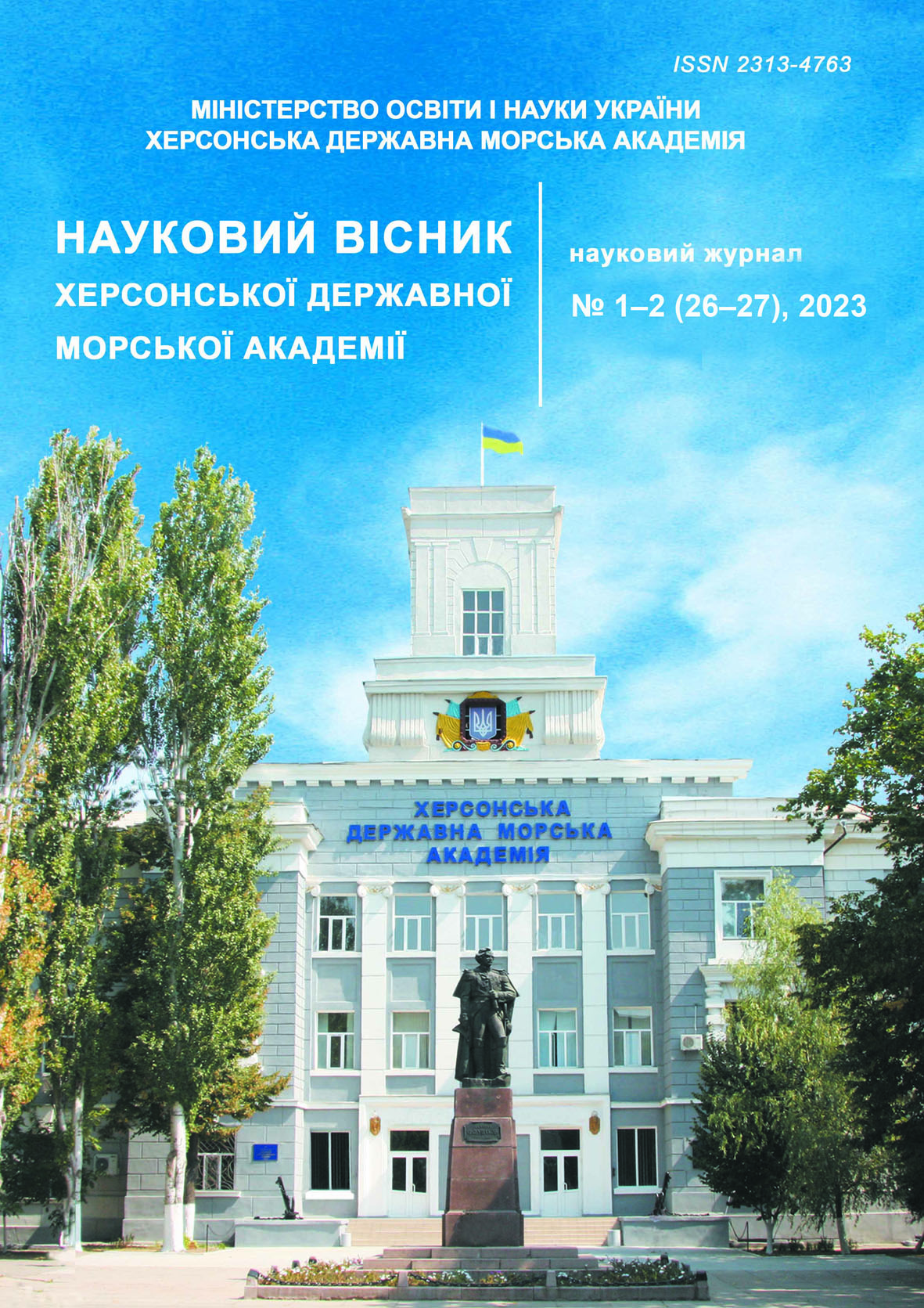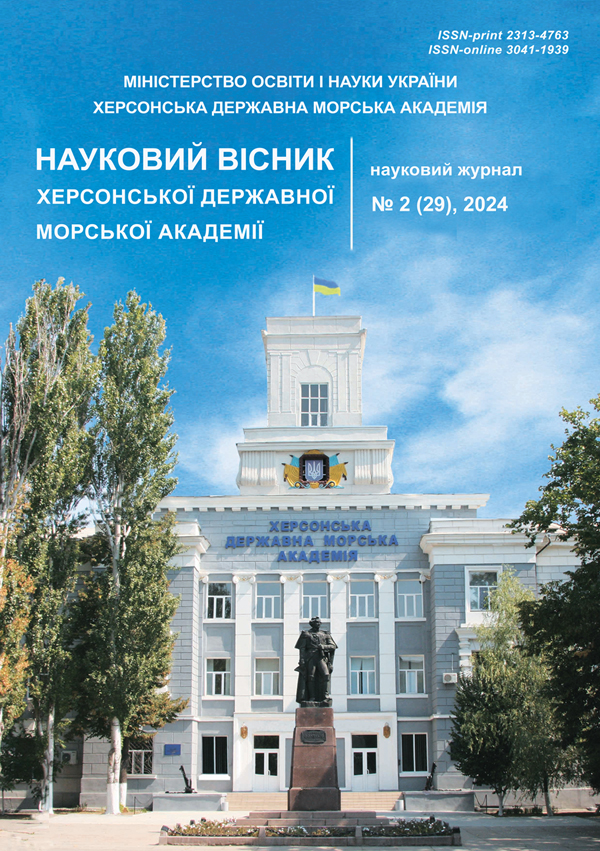FEATURES TO OPTIMIZE BALLAST WATER TREATMENT TECHNOLOGY USING ULTRAVIOLET RADIATION
https://doi.org/10.33815/2313-4763.2024.2.29.070-082
Abstract
The problems of development and implementation of ballast water disinfection technologies using ultraviolet radiation and advanced oxidation processes are considered. The main water parameters that determine the requirements for the total intensity of radiation sources are analysed. A scheme for forming a disinfection effect is proposed, which takes into account the role of radiation factors, water parameters and reagent activity. The biophysical processes that occur when broad-spectrum ultraviolet radiation acts on microorganisms are analysed. Organizational and technical measures that must be taken into account when implementing these technologies on ships are considered. Using the example of a pilot plant, a list of competencies that ship personnel must master to comply with the standards for the operation of the plant is given. The technical and economic indicators of the ballast water disinfection plant are given, which should be used as a basis when designing the plant for the customer. The design of the plant for ballast water disinfection with ultraviolet radiation is proposed. Methods of controlling the formation of sediment on the surface of ultraviolet radiation sources are described and the method of cleaning them from sediment is proposed. A scheme for cleaning ballast water during pumping into the tank and during de-ballasting is developed. The possibility of modular arrangement of the disinfection system is provided for the purpose of optimal location of equipment in ship's premises. A system for automatic control of ballast water purification technology is described. Directions for improving installations for more complete performance of the functions of neutralizing microorganisms carried by ballast water are indicated.
References
2. Varlan, T. (2023). / Application of ballast water treatment systems and minization of harful impacts on the marine ecosystem // No. sge16–01: Science for modern man '2023 https://doi.org/10.30890/2709-2313.2023-16-01-019.
3. Šateikienė, D., Janutėnienė, J. (2012). / Ballast water treatment technologies comparative analysis // Proceedings of 16th International Conference. Transport Means.
4. Apetroaei, M. R., Atodiresei, D. V., Rău, I., Apetroaei, G. M., Lilios, G. and Schroder, V. (2018). / Overview on the practical methods of ballast water treatment // IOP Conf. Series: Journal of Physics: Conf. Series 1122. 012035, https://doi.org/10.1088/1742-6596/1122/1/012035.
5. Bazaleev, N. I., Klepikov, V. F., Lytvynenko, V. V. (1997). / The simulation and forecasting changes in the physical and chemical properties of materials under the influence of radiation // Reports NAS of Ukraine (4), с. 82–86.
6. Bazaleev, N. I., Klepikov, V. F., Lytvynenko, V. V., Shaliapin, S. M. (2005). / Electrophysical Beam Technologies: A New Concept of Water Disinfection with Ultraviolet Rays./ Science and Innovation. v.1., №1. p.99–109.
7. Bazaleev, N. I., Klepikov, V. F., Lytvynenko, V. V. (1998). Electrophysical radiation technologies. Kharkiv: Аcta, p. 206.
8. Donets, S. E., Lytvynenko, V. V., Prokhorenko, E. M. (2021). / Thermographic method for diagnosis and estimation the efficiency of installations for uv ray disinfection of water// Bulletin of Sumy State National Agrarian University. Ser. Mechanization and Automation of Production Processes- v 1 (43). с. 3–7.
9. Kciuk, M., Marciniak, B., Mojzych, M., Kontek, R. (2020). / Focus on UV-Induced DNA Damage and Repair—Disease Relevance and Protective Strategies // Int. J. Mol. Sci, 21, 7264; https://doi.org/10.3390/ijms21197264.
10. Gibson, J., Farnood, R., Seto, P. (2016). Chemical pretreatment of combined sewer overflows for improved UV disinfection. Water Sci Technol 73:375–381. https://doi.org/10.2166/wst.2015.447.
11. Cantwell, R. E., Hofmann, R. (2011). / Ultraviolet absorption properties of suspended particulate matter in untreated surface waters // Water Research. V. 45, Iss. 3, January, Pages 1322–1328 https://doi.org/10.1016/j.watres.2010.10.020.
12. KLymenko, V. G. (2012). Zagalna gidrogeologiya: navchalniy posibnyk dlia studentiv. – Kharkiv. HNU imeni V. N. Karazina, 254 s.
13. Boyko, N. I., Makogon, A. V. (2020). High voltage plant with 3 MW pulse power for disinfection flow of water by nanosecond discharge in gas bubbles. Teknichna electrodynamika. № 5. p. 80‒83. https://doi.org/10.15407/techned2020.05.080.
14. MU 3.2.1757-03 “Sanitary and parasitological assessment of effectiveness. Water disinfection with UV radiation”.
15. https://www.waterlight.pro/uf-znezarazhennya-vody/.
16. Zhang, N., Hu, K., Shan, B. (2013). / Ballast water treatment using UV/TiO2 advanced oxidation processes: An approach to invasive species prevention // Chemical Engineering Journal 243:7–13 https://doi.org/10.1016/j.cej.12.082.
17. Guney, C. B. (2022). / Ballast water problem: Current status and expected challenges // Mar. Sci. Tech. Bull. 11(4): 397–415 https://doi.org/10.33714/masteb.1162688.
18. Gorbov, V. M., Mitienkova, V. S., Tymofeeva, A. S. (2013). The energy efficiency comparative evaluation of ballast water treatment directions // Scientific Bulletin of the Kherson State Maritime Academy. №1 (8). с. 35–44.
19. Turnpenny, A. W. H., Coughlanю, Jю Ng. B., Crews, P., Bamber, R. N., Rowles, P. / Cooling Water Options forthe New Generation of Nuclear Power Stations in the UK // Published by: Environment Agency, Rio House, Waterside Drive, Aztec West, Almondsbury, Bristol, BS32 4UD.
20. Tiron-Vorobiova, N. B., Danylian, A. G., Romanovska, O. R. (2019). Ballast water: Yutkins electro-hydraulic shock is one of the effective ways to disinfect it // Tekhnologii zahystu navkolyshniogo seredovyscha. №4. p. 67–72 https://doi.org/10.15589/znp2019.4(478).10.
21. Maslov, I. Z., Danilyan, A. G., Tiron-Vorobyova, N. B., Romanovska, O. R., Babak, A. A. (2019). / Ballast water treatment plant // Environmental Sciences №2 (25). с. 104–108. https://doi.org/10.32846/2306-9716-2019-2-25-16.






